Eight

Yorkshire
www.boltoncastle.co.uk
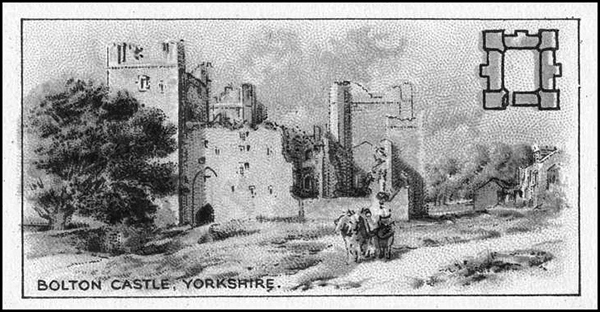
Built in the fourteenth century and located in Wensleydale in Yorkshire, Bolton Castle is a Grade I listed building and a Scheduled Ancient Monument, and remarkably has never been sold and is still in the ownership of the descendants of the Scrope family. Although damaged in the English Civil War, much of it remains and its gardens contain a maze, herb garden, wildflower meadow, rose garden and a vineyard.
After her defeat in Scotland at the Battle of Langside in 1568, Mary Queen of Scots stayed at Bolton for six months. She was allowed to roam the surrounding lands and often went hunting. Mary left Bolton Castle in January 1569, being taken to Tutbury in Staffordshire, where she spent much of her next eighteen years before execution in 1587.
It is said that Mary’s ghost still wanders the grounds and corridors of the castle, and there have been reports of a “Lady in the Dark Cloak”, who has been seen by the current Lord Bolton, a former caretaker, and twice by a villager. Sightings of this mysterious ghost woman have also been recorded at the castle in old books, often claiming it to be the ghost of Mary, Queen of Scots.
Bolton Castle General Manager, Katie Boggis noted in an article in the Harrogate Informer of 25 October 2013 that, “the tale of the lady in the dark cloak is well known to the staff here at the estate. One evening Lord Bolton was locking up at about 5:30 p.m. when he saw a lady across the courtyard. She was going into the East Curtain in what he thought was a dark coat. Thinking that it was a visitor still looking round, he waited outside for five minutes for the lady to finish her tour, but still there was no sign of her. He went into the East Curtain to see what she was doing and found no one there. There is only one entrance and exit to the East Curtain, which he had been standing by throughout. Exactly the same thing happened, but this time in the chapel, a couple of years later.”
South Yorkshire
www.english-heritage.org.uk/visit/places/conisbrough-castle
Initially built in the eleventh century by William de Warenne, the Earl of Surrey, after the Norman Conquest, Conisbrough Castle is a medieval fortification in South Yorkshire. Later, in the late twelfth century, Hamelin Plantagenet, the illegitimate son of Henry II, acquired the property by marriage and it was subsequently rebuilt in stone and remained in the family until the fourteenth century, despite being seized several times by the Crown.
The castle fell into ruin with its outer wall badly affected by subsidence, and its derelict state prevented it from involvement in the English Civil War. It was later purchased by the Duke of Leeds in 1737 and by the end of the nineteenth century it had become a tourist attraction. Interestingly, Sir Walter Scott used the location for his 1819 novel Ivanhoe. English Heritage took over the management and control of the castle in 2008 and it continues to operate as a tourist attraction.
The spirit of a gray monk has been seen stalking the ruined curtain walls and the ghost of a White Lady has been seen at the top of the keep, where it is believed she was pushed over the edge to her death. As well, disembodied footsteps have been heard in the keep and peculiar lights have been reported from the chapel area of the castle.
Yorkshire
www.english-heritage.org.uk/visit/places/helmsley-castle
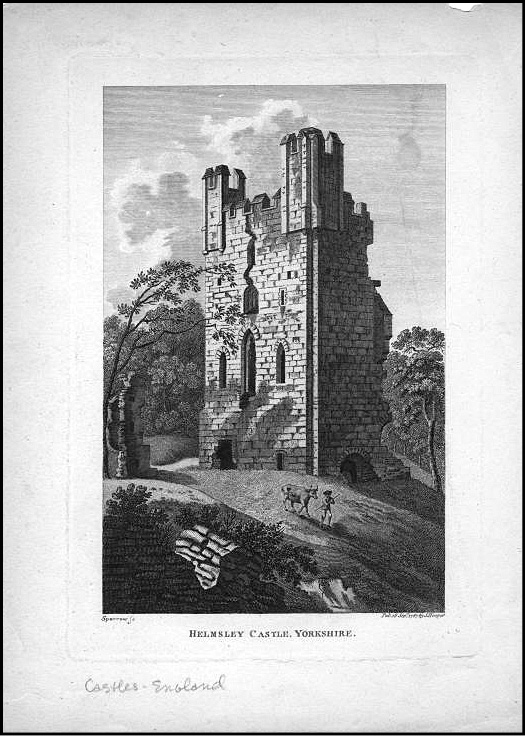
A desolate and windswept ruin situated in the market town of Helmsley in North Yorkshire, Helmsley Castle was originally constructed in wood around 1120 by Walter l’Espec and later converted to stone. In 1478 it was sold to Richard, Duke of Gloucester who later became Richard III. During the English Civil War, it was besieged by Sir Thomas Fairfax although the defender, Sir Jordan Crosland held it for three months before surrendering. Parliament ordered the castle to be slighted and much of the walls, gates and part of the east tower were destroyed. It is now owned by the Feversham family of Duncombe Park, although in the care of English Heritage.
The castle is reputed to be haunted by the ghost of a soldier who is believed to have originated from around the time of the English Civil War. As well, the ghost of a Green Lady, her green dress rustling in the breeze, has also been seen inside and outside of the castle during the dead of night. And in another bizarre tale, strange pixie-like creatures have been reported wandering the castle grounds, as well as the surrounding countryside.
In 2008, a team of paranormal investigators from the Northern Ghost Research Investigation Team UK was invited to investigate the castle by English Heritage after staff had reported strange occurrences, and although they produced no concrete evidence, they reported some interesting phenomena including flashing lights, thrown stones, disembodied footsteps and objects moving of their own accord.
Yorkshire
www.harrogate.gov.uk/info/20153
/knaresborough_castle_and_museum
Overlooking the River Nidd in North Yorkshire, Knareborough Castle was first built around 1100 and there is documented evidence dating from 1130 referring to works carried out at the castle by Henry I. Interestingly, Hugh de Moreville and his followers took refuge in the castle during the 1170s after assassinating Thomas Becket.
King John took control of the castle in 1205 as it was an important northern fortress. It was later rebuilt between 1307 and 1312 by Edward I and later completed by Edward II. John of Gaunt later acquired the castle in 1372.
The castle was taken by Parliamentarian troops in 1644 during the English Civil War and was destroyed after an order from Parliament to dismantle all Royalist castles. The ruins are open to the public and are often used as a performing space.
The castle is haunted by the ghost of a man standing above the ghost of another person lying prone on the ground, with his right arm raised as if to strike the figure lying on the ground. These ghosts appear as misty indistinct shapes and not much is known about their respective origins.
Yorkshire
www.english-heritage.org.uk/visit/places/middleham-castle
Once the childhood home of Richard III, Middleham Castle was originally constructed by Robert Fitzrandolph, 3rd Lord of Middleham.
In 1258, Mary Fitzrandolph inherited the castle and in 1260 she married Robert Neville. The Nevilles rose to become one of the most powerful families in England and held the castle until the late fifteenth century. On the accession of Edward IV in 1461, his younger brother Richard was made Duke of Gloucester and, at the age of thirteen, he entered Warwick’s household at Middleham, remaining there until toward the end of 1468.
Richard became Protector of the Realm upon Edward IV’s death in 1483. Later that year he was crowned Richard III, usurping his twelve-year-old nephew, Edward V. However, he spent little time at Middleham in his two-year reign and after his death in 1485, the castle remained in royal hands until the reign of James I, when it was sold. It fell into disrepair during the seventeenth century and although garrisoned during the English Civil War, saw no action. The ruins are now in the care of English Heritage.
In recent years there have been reports of the sounds of muffled sixteenth-century music emanating from the empty castle, while the ghostly sounds of battle come from outside the castle and a knight on horseback charges at those who hear them, only to fade away before making contact. As well, people have reported seeing an inexplicable blue light at the top of the south wall as well as the sound of ghostly solders marching.
Interestingly, the castle is reputed to be the site of a buried hoard of treasure and to find it one must run around the castle three times and where they stop the treasure will be found. Unfortunately no one knows exactly where to start, so the treasure remains hidden.
North Yorkshire
www.english-heritage.org.uk/visit/places/pickering-castle/
Originally built by the Normans in 1069 as a timber and earth motte-and-bailey, it was later developed into a stone motte-and-bailey castle. It is situated in the Vale of Pickering with a steep cliff on the west side which would have made for a superb defensive position. In 1926, the Ministry of Works, which is now English Heritage, took over running of the castle and it remains particularly well preserved as it was one of the few castles not to be severely affected by the fifteenth-century Wars of the Roses and the English Civil War of the seventeenth century.
While the castle was used to maintain control of Northern England, it never really played a serious role in any of the British wars and was used more often than not by various Kings while on hunting trips. However, despite its relatively peaceful existence, it does offer sanctuary to one ghostly inhabitant, that being a robed monk, whose faceless form drifts across the grounds toward the ruined keep, his hands outstretched as though carrying some invisible item. It has also been suggested by those who have been close enough to notice that his face is bloodied. And apart from that, there have been bizarre stories of weird pixie-like creatures that have been spotted around the castle itself.
Yorkshire
www.pontefractcastle.co.uk
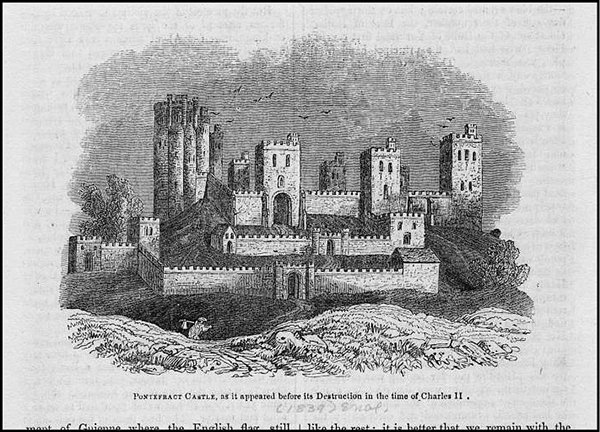
Pontefract Castle is situated to the east of the town of Pontefract and was constructed in approximately 1070 by Ilbert de Lacy on land granted to him by William the Conqueror. It is the site of a series of famous sieges during the English Civil War. King Richard II is thought to have died there.
During the twelfth century, King Henry I confiscated the castle, although his successor, King John returned the castle to de Lacy in 1199 after he ascended the throne. Roger died in 1213 and was succeeded by his eldest son, John. However, the King once again took possession of the castle. In 1311 the castle passed by marriage to the estates of the House of Lancaster.
Hundreds of soldiers were killed or imprisoned in the castle during the Wars of the Roses, and the place had such a feared reputation that it was even mentioned in the works of Shakespeare. Given this, there is little wonder that it is rumored to be haunted.
The ghosts that haunt this ruined but nevertheless spectacular site include a dark and menacing spectral figure holding an axe who wanders around the ruins of the castle, and a ghostly black monk who walks from the castle kitchen toward the Queen’s Tower in the late afternoons. Visitors have reported seeing a ghostly woman in gray holding a lantern near the castle gates as well as two ghostly children who have been sighted playing near the dungeon of the castle. There are also reports of various apparitions of other monks who seem to wander aimlessly through the ancient ruins.
Yorkshire
www.english-heritage.org.uk/visit/places/richmond-castle
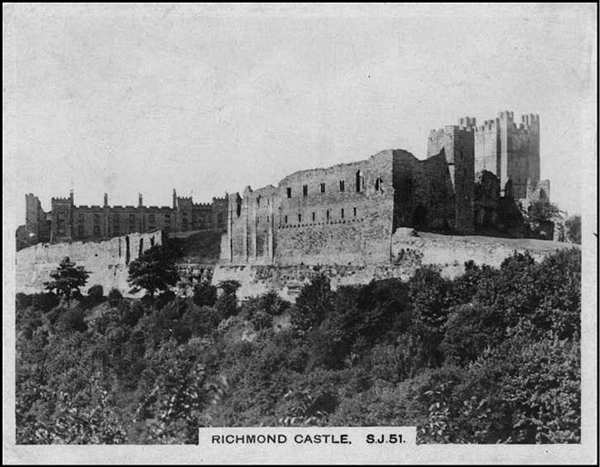
Rising above the River Swale, Richmond Castle was originally called Riche Mount, “the strong hill” and was built by Alan Rufus between 1070 and 1086 after the ‘Harrying of the North’, an ethnic cleansing event by the ruling Normans that depopulated large areas of Yorkshire. Evidence suggests the early castle was originally built from stone, unlike most Norman castles that began as wooden motte-and-bailey castles and later evolved to stone fortifications. Notably, it lacks the earthworks common among castles of the period.
In 1158 it was seized by Henry II of England and it is suspected that he completed the construction of the keep. At roughly the same time, the castle was also strengthened by the addition of towers and a barbican. However, by the end of the fourteenth century it had largely fallen out of use as a fortress and no more major improvements were added. By 1538 a survey noted that it was partly in ruins.
In 1855 a barracks block was built in the great courtyard as the castle became the headquarters of the North Yorkshire Militia. In addition, from 1908 to 1910, the castle was the home of Robert Baden-Powell, the founder of the Boy Scouts, while he commanded the Northern Territorial Army. The barracks were demolished in 1931. Today the castle is a Scheduled Monument and a Grade I listed building and comes under the care of English Heritage.
Legend suggests that the castle is in fact the final resting place of King Arthur and the Knights of the Round Table, who lie sleeping and awaiting the day when they will come back to defend the realm in England’s greatest time of need. It is said that they were once discovered by a potter named Potter Thompson, who recognized Arthur due to the horn and legendary sword Excalibur, which were both resting on a nearby table. So as to prove his story, he decided to take Excalibur, however, as he started to remove the sword from its scabbard, the sleeping knights began to wake and he became frightened, running from the cave. Once outside he regained his composure and turned back toward the entrance only to find that it had completely disappeared. The secret entrance has never been found since.
But whereas this is a simple folklore story, another legend tells that a drummer boy was lost while investigating an underground tunnel and that his ghostly drumming is sometimes heard around the castle. As well, in the late 1990s, one of the castle guides leaving the tower room noticed a ghost walking between two closed doors. The tower room is also said to experience poltergeist activity which was apparently brought on after the chimney was unblocked in the middle of the twentieth century. In addition, the ghost of a nun is said to walk around at night, knocking on bedroom doors.
Yorkshire
www.ripleycastle.co.uk
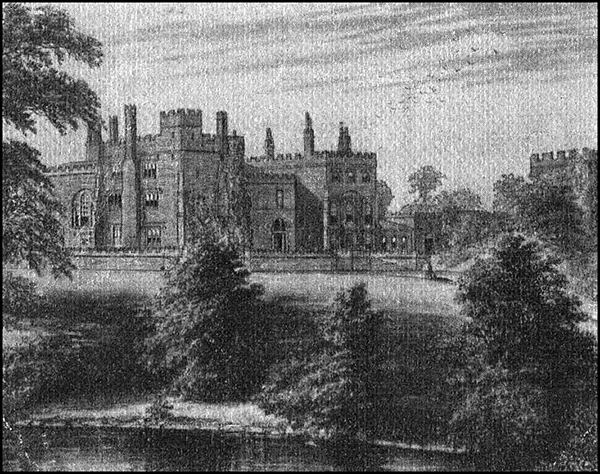
A Grade I listed country house roughly five kilometers north of Harrogate, Ripley Castle was constructed in the fourteenth century and has been the seat of the Ingleby baronets for over 700 years and 28 generations. First acquired by Sir Thomas Ingleby as dowry for marrying Edeline Thwenge, it has a long and illustrious history including Thomas’ oldest son, also called Thomas, who saved the King from being gored by a wild boar and was knighted in honor of his bravery with a boar’s head symbol as his crest. In 1548 Sir William Ingleby, who was High Sheriff of Yorkshire in 1564–65, added a tower to the building.
In 1603 Sir William Ingleby hosted James VI of Scotland when the king was on his way to his coronation as James I of England, and in 1605 he was involved in the Gunpowder Plot, when he allowed the plotters to stay at the castle. He was later arrested and charged with treason but was acquitted. During the Civil War the Ingleby’s sided with Charles I although the castle remained largely untouched by war.
A tragic and forlorn figure dressed in nineteenth century clothes has been seen at the castle. She is said to be the ghost of Lady Alicia Ingelby, who lost her only two children to meningitis in the 1870s. People have reported seeing her figure walking toward the children’s bedrooms before passing unimpeded through a locked door. Indeed, the present Lady Emma Ingelby would often be feeding her baby when, if the baby gave a whimper, she would feel a nudge and a tug at the bedclothes. Her husband, Sir Thomas Ingelby, noted, “She would feel someone tugging the bedclothes, as if saying, wake up, your baby needs you. In the same area a couple of our guides have seen a lady in 1870s dress walking across the hallway. We believe it is Lady Alicia Ingelby. She is a very benevolent ghost.”
Apart from that, inside the topmost tower, a poltergeist is reputed to move children’s toys and becomes disturbed at the sound of babies crying. As well, the priest hole where Frances Ingelby hid before he was captured and executed is said to be haunted by his ghostly presence. And as befits such a place, there are the stories of civil war soldiers, lined up and shot by Cromwell’s firing squad after the battle at Marston Moor. Their ghosts are said to haunt the castle walls.
Yorkshire
www.english-heritage.org.uk/visit/places/scarborough-castle
Scarborough Castle is situated on a rocky headland overlooking the North Sea and Scarborough in North Yorkshire. The present stone castle dates from the 1150s and was strengthen over the centuries to guard the Yorkshire coastline and the north of England from Scottish or continental invasion. It was fortified and defended during various civil wars, sieges and conflicts, indeed, in 1557 Thomas Stafford seized the castle and held it for three days, believing he could incite a popular revolt against Queen Mary. However, the castle was easily captured, and Stafford and his accomplices were executed.
196
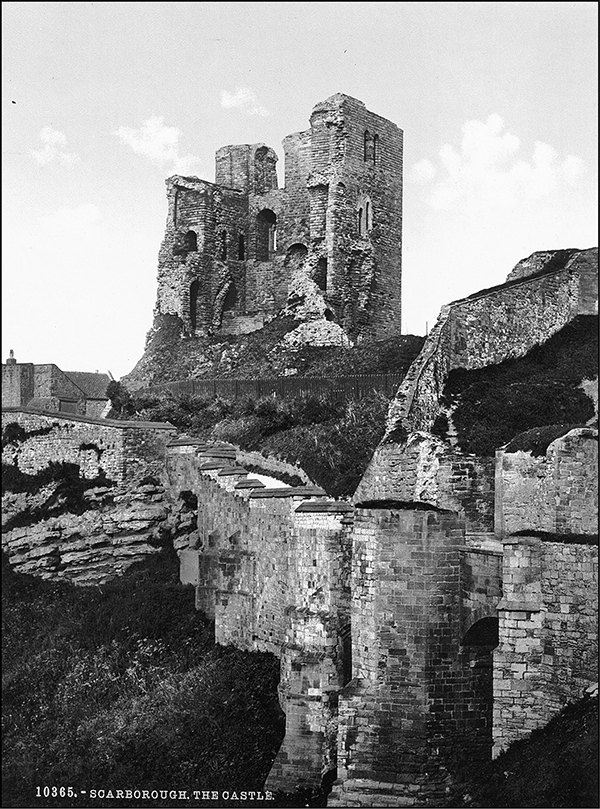
The conclusion of civil and continental wars in the seventeenth century led to its decline in importance, and it has been a ruin since the end of the English Civil War although, from the 1650s the castle also served as a prison and its prisoners included George Fox, founder of the Society of Friends (the Quakers). It is now a tourist attraction and managed by English Heritage.
Piers Gaveston, the 1st Earl of Cornwall who was beheaded in 1312, spent his last free days in the castle. His ghost is said to have returned to the last place where he saw peace and freedom and now it wanders the ruins, a solitary figure dressed in medieval clothes. One legend suggests that his ghost sometimes tries to lure visitors to the cliff edge before attempting to push them off.
It is not known why this ghost is said to be that of Gaveston, but it has been documented that the entity, which has been witnessed on numerous occasions, has a threatening presence and that “visitors have felt unnerved, even in broad daylight, while walking the battlements, suddenly overcome with a dreadful sense that they are not alone. It is quite enough to persuade them to quicken their pace.”
North Yorkshire
www.castlesfortsbattles.co.uk/yorkshire
/sheriff_hutton_castle.html
Sheriff Hutton Castle is a quadrangular castle built by John, Lord Neville in the late fourteenth century. A license to crenellate was granted by Richard II in 1382 that formally made it a castle. It was later inherited by Richard Neville, also known as Warwick the Kingmaker, who at one point was the richest and perhaps most powerful man in England. However, when Warwick died in 1471, Edward IV appropriated the castle and gave it to Richard, Duke of Gloucester, who later became Richard III.
During the sixteenth century, Henry VIII’s illegitimate son Henry Fitzroy lived in the castle under the care of Cardinal Wolsey, although soon after it began to fall into a state of disrepair, remaining the property of the crown until sold in 1940 to textile baron Wilfred Wagstaff.
Although relatively quiet in supernatural terms, the castle does claim one unearthly inhabitant—a ghostly girl. Current owner Dr. Richard Howarth in an article in Farmers Weekly noted, “we have a benign ghost, Nancy, probably a former lady-in-waiting. Several people have seen her including my father, who was a down-to-earth Yorkshire farmer.”
This lack of ghosts raises an interesting question. Why is it that some castles with similar histories to Sheriff Hutton castle are allegedly haunted by numerous ghosts whereas Sherriff Hutton is not? If anything, when one walks the lonely ruins of this once magnificent structure, one would suspect that it has a long and varied history of various ghosts and hauntings, and yet, it doesn’t.
North Yorkshire
www.skiptoncastle.co.uk
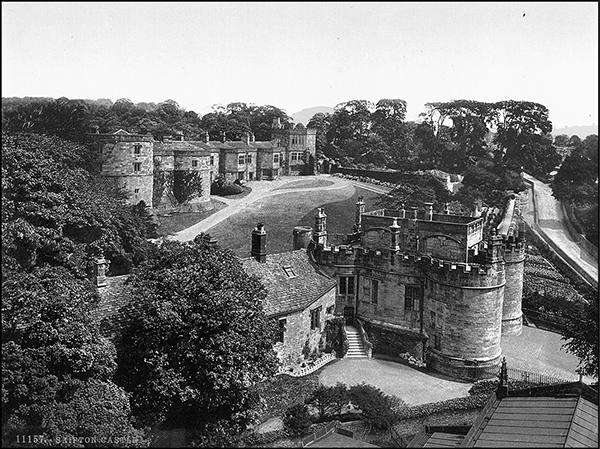
Constructed in 1090 by Robert de Romille, Skipton Castle is one of the most complete and best preserved medieval castles in England. Originally a motte-and-bailey castle, it was later rebuilt in stone to withstand attacks by the Scots with the cliffs behind the castle making it an easily defended position. In 1310, Edward II granted the castle to Robert Clifford, who was appointed Lord Clifford of Skipton. He commissioned many improvements but died in the Battle of Bannockburn in 1314 before many of these additions could be completed.
During the English Civil War, the castle was the last Royalist bastion in the North, only yielding to Parliament after a three-year siege in 1645 when a surrender was negotiated between Oliver Cromwell and the defending Royalists. Legend has it that during the siege, sheep fleeces were hung over the walls to deaden the impact from the rounds of cannon fire and these days sheep fleeces feature in the town’s coat of arms.
Cromwell ordered the castle to be slighted but it was later fully restored by Lady Anne Clifford and it remained the Clifford’s principal seat until 1676. Lady Anne Clifford was the last of her family to own the castle.
With such a history one would expect, like other similar castles, that Skipton Castle would have a long and mysterious history of ghosts and supernatural happenings; however, somewhat unexpectedly, it is relatively quiet. However, this is not to say that it is completely uninhabited by ghostly presences as the spirit of a lady with red hair, who some believe to be Mary Queen of Scots, has been seen gazing forlornly out of the windows, while Lady Anne Clifford’s spectral carriage is supposed to drive madly up the High Street, through the closed gates where it stops outside the door, where she will collect the spirit of the castle’s owner upon their death.
Mark Whitaker and his partner Amanda Ledgar visited the castle in 2014 and took what can only be described as a quite compelling photograph, that of what appears to be a ghostly girl in a white floor length period dress and a bonnet that appears to float where her head would be. Oddly enough the figure appears to have visible arms and a visible neck.
Whitaker only noticed the figure when he got back to his home in Colne, Lancashire and noted, “It actually sent a shiver down my spine as I didn’t see it until I transferred it to my computer. I think it’s a ghost of a little girl of some kind, especially with what she is wearing. She has a dress and bonnet that I think is like what they would wear two or three hundred years ago.”
He also added, “It looks like she is walking away from the picture past a wall that is only about two or three feet high, so she must be an infant. There would have been high infant mortality rates in that period. It creeps me out, it really does still just looking at it. Amanda always finds it creepy too.”
Yorkshire
www.english-heritage.org.uk/visit/places/spofforth-castle
Built by Henry de Percy in the early fourteenth century after being given a license to crenellate a manor house on the site, Spofforth Castle is a ruined, fortified manor house in North Yorkshire.
In 1408, the castle and Percy estate were confiscated after the failed rebellion against King Henry IV, and later given to Sir Thomas Rokeby. They were later restored but were lost again in 1461 when the Percys supported the losing side in the War of the Roses. The castle was eventually returned to the family but was reduced to ruins during the English Civil War.
Now run by English Heritage as a Grade II listed building, it has a number of ghostly tales associated with it including the apparition of a half-human form that has been seen falling to its death from the tallest tower. This bluish-white form is said to be seen standing on the tiny parapet at the top of the eighteenth-century tower of the ruined castle before hovering for a few moments and then falling to the grass path below. In 1969 a group of schoolchildren and their teacher witnessed the phenomena, as did two picnickers in 1973.